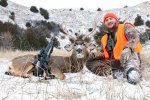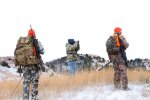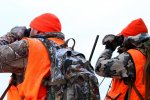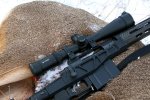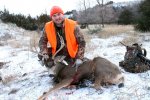Heres a blog I did about a recent build on one of our customer sweepstakes hunt giveaways...
I recently was given an opportunity for a “dream hunt” for Whitetail and Mule deer in central Nebraska. This was a sweepstakes giveaway for one lucky hunter and his guest and I was fortunate enough to get to go along to represent the company and….hopefully…bag myself a nice deer as well!
Since the hunt was sponsored by OpticsPlanet and Vortex Optics I was saving a lot of out of pocket expenses. Private guided hunts carry a steep price tag, another reason I was so humbled to be invited on this hunt. Though this hunt was still costly, due to this unexpected savings, I had the urge to build a new rifle to take to Nebraska. I had been planning on building a long range target magnum rifle, so this was my “reasoning” to go to the distance with this build.
I have been, and will always be, an admirer and avid enthusiast of the 300 Winchester Magnum. Throwing 150 grainers at over 3500 fps and then 180 gr’s at 3000 fps and still the ability of hitting at over 3400 lbs., yes sir, I take it. 50 yards to over 1500 yards, the 300 WM will get it done. Needless to say, it was an easy choice for me. I wanted and eventually chose the Federal Nosler Partition 300 Win mag 180 grainers. These loads will take down any deer as well as much larger game. A good heavy bullet that is built for any job.
So, I knew the cartridge I wanted. Now the action decision needed to be made. Well, I’m a 700 fan as well. Own them, use them, love them. I’m experienced with the 700 action and I’m comfortable with it. That, the ability to be comfortable, is probably my #1 criterion for a choice of this kind. the options for upgrades are also limitless.
I have a buddy whose big into the LR shooting, does most of his own work so I pick his brain for knowledge all the time, and for this build, I asked him about triggers. It was easy, the answer was Jewell. I figured it would be nice on a hunting stick and later on as a target rifle. Ability to adjust to about 2.5-3lbs. for hunting and then drop to a few ounces for a bench rifle? Yes, please. The big difference in my trigger selection was that I went with a bottom safety model. I’ll come back to why I did so.
This brought me to my decision on the stock I wanted to use. I had been eyeballing the new aluminum chassis systems for a while. I loved the idea of just dropping in a barreled action of your choice (assuming that fit was available, which was another bonus for the 700), tightening it down, and you’re ready to roll. I looked at McRee, XLR, AI, Whiskey, etc. I sent emails to a few manufacturers directly with some specific questions. The only manufacturer that took the time to answer my questions was Kyle from XLR Industries. Carries a lot of water to have a higher up at a company take some time out to help out a ‘standard’ sale. This turned me on to research XLR even more. Looked up reviews, options, styles, etc. Thru correspondence with Kyle, I learned of the new Carbon XLR chassis for the long action 700. This was a carbon fiber forend model with milled out material in the receiver area to cut down on some weight, about 8 oz. I was sold. Great design, lighter weight, and good looking. The XLR system takes AI magazines so the 5 rounders would be perfect for my hunt and I can get 10 rounders later when I turn the 700 into a target build.
An add on that I decided to go with after some thought was the folding stock adapter. Most hunters would say that’s not the brightest idea, but let me just say, thank God I did! I’m 6’4’’, 280, play some ball, and enjoy the weight room. I’m not a little guy. If you have ever tried jumping in and out of a truck in the winter, with lots of layers on, while holding a full length rifle, it’s not easy when you’re my size. The ability to fold the buttstock on my rifle proved very helpful in saving that little bit of room and making the transition in and out of the truck a breeze. Also, I don’t think I’ve ever held a more solid folding stock designed rifle, ever; extremely solid lock up. In the folded position, it also makes overal transport much much easier.
For this hunt, I left the factory barrel on, didnt want to go with a heavier contour to add weight. I knew it would already be a heavier setup than my usual, but I really liked those added features. Rifle came out to just over 10 pounds unloaded, which for a central Nebraska hunt was bad at all. Carried it for 3-4 hours at most at a time. Good amount of windshield time on this hunt.
With this style of chassis/stock, the grip isn’t your typical stock style grip in the wrist. It’s an AR platform style grip. I shoot a lot of AR rifles and am very comfortable with that style of grip...just a product of my generation. A second huge feature is that these grips are interchangeable with many AR grips on the market. Ergo grips, finger groove grips, larger swells, etc, there is a grip to fit your hand/palm best. Now, because of this AR style grip and your hand placement, the standard safety on top next to the bolt is a little more awkward to reach if gripping the rifle. Not that it can't be done easily, but i saw that Jewell makes a bottom safety model that places the safety inside the trigger guard.
I was first a little apprehensive to try this, having a safety near the trigger could OBVIOUSLY cause issues. Especially with gloves on while hunting. So, when I received the trigger, I immediately began testing it out. I flipped that safety back and forth so many times in every way I could think of. No gloves, with gloves, shouldering it quickly, after exercising so I’m winded, with cold fingers, and more. Even carried it thru brush, some thick stuff too, to see if any twigs or branched would get in there and wreap havoc. That safety was solid and I was comfortable working it. It also was a hard solid motion so it cannot easily be switched off. After some practice, I was extremely happy with it. I knew it also would be nice when converting this rifle and stock to a target setup. (I'm just a guy who likes having a safety...I admit it)
Alright, its scope time. Well, this hunt was for Vortex optics, so I was scoping this rifle with a Vortex. I was excited because I have had only limited use with Vortex scopes and this would really be a way to test out one of their optics in the field, and a cold November winter with snow and Ice...make for a good test. I chose to run the new Vortex Viper HS-T. This is a 4-16x variable magnification scope with a 44mm objective. I love the 4-16 magnification range, anything from 50 yards to around 500 yards would be in my comfort zone on a hunt. 44mm objective is large enough to allow ample light into the scope. I wasn’t worried about optical center height at all. The XLR has that adjustable cheek pad so almost any height would be comfortable and that is factored into my drop calculations, so no worries there either. First impressions of the scope were outstanding. Vortex made this scope to be a bridge from hunting to the target side, and they succeeded. The turrets were solid and crisp and also featured Vortex’s CRS zero stop system for an easy return to zero. The small features really made a difference, as in the fiber optic rod to show your zero, small feature but extremely helpful.
I opted to go with the Mil radian turret matched with a mil radian reticle. I have always used MOA turrets while hunting, but in this case the MIL/MIL version was the only one available so I had to give it a go. Let’s just say, I am pleased I did. Using a MIL/Mil system is a breeze and it carried right over into my hunting realm. Just a short amount of time practicing made me very comfortable with the new system.
For a mount system, I went with the EGW HD long action mount for a Remington 700. A rail base allows for more movement of rings and therefor the ability to work with eye relief a little more and really get the best placement possible. Due to my setup being a magazine fed system from the bottom, loading from the top and any interference because of a one piece base was a non-factor. I did end up cutting off about .5’’ of the rail to allow a better fit for my XLR stock. Easy job for a Dremel though. As for rings, I went with the new Vortex Viper ring set. This seems like a normal set of rings, but there is a lot at work there. This is vertical looking ring set, which esthetically, I love. However, the lower slip is at about the 4’o’clock position. This means that the base can be securely attached the rail and then the scope can be placed into the lower portion of the ring and almost clamps in. It essentially combines the best from the Warne vertical ring with a Leupold PRW rings. Easy to mount, secure, strong, and a very good looking design.
For this hunt I wanted to go with a bipod/tripod system that I can use while standing or seated. I chose to go with the Stoney Point PoleCat Explorer Tripod/bipod/monopod. I was lucky enough for my boss to lend me his for this trip. This is an outstanding design. It’s essentially a bipod with a third leg. So, it acts as a tripod for maximum support so you can lean into it. It also adjusts from 25’’ to 62’’, which was perfect for me either seated or standing. The third leg can be removed so the system can be used as a bipod or that leg can be used as a monopod itself. I myself used it as a hiking staff while climbing down one bluff. Truly proved extremely useful for me on this trip. I also took along the New OPMOD CUSS sling. Nice thing about this sling is the ability to attach it almost anywhere and to anything. I attached the front loop to the swivel stud and the rear loop to the buttstock. No need for swivels there.
Few hours of rangetime, simple barrel break-in, and a lot of handling the rifle at home prepped me and reassured this was a working rifle that I could depend on. This was a working rifle and it paid off. have a real nice Mulie coming home in a left looking semi sneak in a few months.
Few things I wish I would have changed...Probably would have cut the barrel down to 23, maybe even 22''. Would have shaved a little more weight and for its intended purpose, hunting within 600 yards, that is more than plenty to get the velocity I would want.
All in all, it was a fun build. Have a action that will be sent off to have the works done to it and a new barrel. then it will come home to an outstanding stock system. Thats why we do this, the passion and the challenge.
Trevor B.
I recently was given an opportunity for a “dream hunt” for Whitetail and Mule deer in central Nebraska. This was a sweepstakes giveaway for one lucky hunter and his guest and I was fortunate enough to get to go along to represent the company and….hopefully…bag myself a nice deer as well!
Since the hunt was sponsored by OpticsPlanet and Vortex Optics I was saving a lot of out of pocket expenses. Private guided hunts carry a steep price tag, another reason I was so humbled to be invited on this hunt. Though this hunt was still costly, due to this unexpected savings, I had the urge to build a new rifle to take to Nebraska. I had been planning on building a long range target magnum rifle, so this was my “reasoning” to go to the distance with this build.
I have been, and will always be, an admirer and avid enthusiast of the 300 Winchester Magnum. Throwing 150 grainers at over 3500 fps and then 180 gr’s at 3000 fps and still the ability of hitting at over 3400 lbs., yes sir, I take it. 50 yards to over 1500 yards, the 300 WM will get it done. Needless to say, it was an easy choice for me. I wanted and eventually chose the Federal Nosler Partition 300 Win mag 180 grainers. These loads will take down any deer as well as much larger game. A good heavy bullet that is built for any job.
So, I knew the cartridge I wanted. Now the action decision needed to be made. Well, I’m a 700 fan as well. Own them, use them, love them. I’m experienced with the 700 action and I’m comfortable with it. That, the ability to be comfortable, is probably my #1 criterion for a choice of this kind. the options for upgrades are also limitless.
I have a buddy whose big into the LR shooting, does most of his own work so I pick his brain for knowledge all the time, and for this build, I asked him about triggers. It was easy, the answer was Jewell. I figured it would be nice on a hunting stick and later on as a target rifle. Ability to adjust to about 2.5-3lbs. for hunting and then drop to a few ounces for a bench rifle? Yes, please. The big difference in my trigger selection was that I went with a bottom safety model. I’ll come back to why I did so.
This brought me to my decision on the stock I wanted to use. I had been eyeballing the new aluminum chassis systems for a while. I loved the idea of just dropping in a barreled action of your choice (assuming that fit was available, which was another bonus for the 700), tightening it down, and you’re ready to roll. I looked at McRee, XLR, AI, Whiskey, etc. I sent emails to a few manufacturers directly with some specific questions. The only manufacturer that took the time to answer my questions was Kyle from XLR Industries. Carries a lot of water to have a higher up at a company take some time out to help out a ‘standard’ sale. This turned me on to research XLR even more. Looked up reviews, options, styles, etc. Thru correspondence with Kyle, I learned of the new Carbon XLR chassis for the long action 700. This was a carbon fiber forend model with milled out material in the receiver area to cut down on some weight, about 8 oz. I was sold. Great design, lighter weight, and good looking. The XLR system takes AI magazines so the 5 rounders would be perfect for my hunt and I can get 10 rounders later when I turn the 700 into a target build.
An add on that I decided to go with after some thought was the folding stock adapter. Most hunters would say that’s not the brightest idea, but let me just say, thank God I did! I’m 6’4’’, 280, play some ball, and enjoy the weight room. I’m not a little guy. If you have ever tried jumping in and out of a truck in the winter, with lots of layers on, while holding a full length rifle, it’s not easy when you’re my size. The ability to fold the buttstock on my rifle proved very helpful in saving that little bit of room and making the transition in and out of the truck a breeze. Also, I don’t think I’ve ever held a more solid folding stock designed rifle, ever; extremely solid lock up. In the folded position, it also makes overal transport much much easier.
For this hunt, I left the factory barrel on, didnt want to go with a heavier contour to add weight. I knew it would already be a heavier setup than my usual, but I really liked those added features. Rifle came out to just over 10 pounds unloaded, which for a central Nebraska hunt was bad at all. Carried it for 3-4 hours at most at a time. Good amount of windshield time on this hunt.
With this style of chassis/stock, the grip isn’t your typical stock style grip in the wrist. It’s an AR platform style grip. I shoot a lot of AR rifles and am very comfortable with that style of grip...just a product of my generation. A second huge feature is that these grips are interchangeable with many AR grips on the market. Ergo grips, finger groove grips, larger swells, etc, there is a grip to fit your hand/palm best. Now, because of this AR style grip and your hand placement, the standard safety on top next to the bolt is a little more awkward to reach if gripping the rifle. Not that it can't be done easily, but i saw that Jewell makes a bottom safety model that places the safety inside the trigger guard.
I was first a little apprehensive to try this, having a safety near the trigger could OBVIOUSLY cause issues. Especially with gloves on while hunting. So, when I received the trigger, I immediately began testing it out. I flipped that safety back and forth so many times in every way I could think of. No gloves, with gloves, shouldering it quickly, after exercising so I’m winded, with cold fingers, and more. Even carried it thru brush, some thick stuff too, to see if any twigs or branched would get in there and wreap havoc. That safety was solid and I was comfortable working it. It also was a hard solid motion so it cannot easily be switched off. After some practice, I was extremely happy with it. I knew it also would be nice when converting this rifle and stock to a target setup. (I'm just a guy who likes having a safety...I admit it)
Alright, its scope time. Well, this hunt was for Vortex optics, so I was scoping this rifle with a Vortex. I was excited because I have had only limited use with Vortex scopes and this would really be a way to test out one of their optics in the field, and a cold November winter with snow and Ice...make for a good test. I chose to run the new Vortex Viper HS-T. This is a 4-16x variable magnification scope with a 44mm objective. I love the 4-16 magnification range, anything from 50 yards to around 500 yards would be in my comfort zone on a hunt. 44mm objective is large enough to allow ample light into the scope. I wasn’t worried about optical center height at all. The XLR has that adjustable cheek pad so almost any height would be comfortable and that is factored into my drop calculations, so no worries there either. First impressions of the scope were outstanding. Vortex made this scope to be a bridge from hunting to the target side, and they succeeded. The turrets were solid and crisp and also featured Vortex’s CRS zero stop system for an easy return to zero. The small features really made a difference, as in the fiber optic rod to show your zero, small feature but extremely helpful.
I opted to go with the Mil radian turret matched with a mil radian reticle. I have always used MOA turrets while hunting, but in this case the MIL/MIL version was the only one available so I had to give it a go. Let’s just say, I am pleased I did. Using a MIL/Mil system is a breeze and it carried right over into my hunting realm. Just a short amount of time practicing made me very comfortable with the new system.
For a mount system, I went with the EGW HD long action mount for a Remington 700. A rail base allows for more movement of rings and therefor the ability to work with eye relief a little more and really get the best placement possible. Due to my setup being a magazine fed system from the bottom, loading from the top and any interference because of a one piece base was a non-factor. I did end up cutting off about .5’’ of the rail to allow a better fit for my XLR stock. Easy job for a Dremel though. As for rings, I went with the new Vortex Viper ring set. This seems like a normal set of rings, but there is a lot at work there. This is vertical looking ring set, which esthetically, I love. However, the lower slip is at about the 4’o’clock position. This means that the base can be securely attached the rail and then the scope can be placed into the lower portion of the ring and almost clamps in. It essentially combines the best from the Warne vertical ring with a Leupold PRW rings. Easy to mount, secure, strong, and a very good looking design.
For this hunt I wanted to go with a bipod/tripod system that I can use while standing or seated. I chose to go with the Stoney Point PoleCat Explorer Tripod/bipod/monopod. I was lucky enough for my boss to lend me his for this trip. This is an outstanding design. It’s essentially a bipod with a third leg. So, it acts as a tripod for maximum support so you can lean into it. It also adjusts from 25’’ to 62’’, which was perfect for me either seated or standing. The third leg can be removed so the system can be used as a bipod or that leg can be used as a monopod itself. I myself used it as a hiking staff while climbing down one bluff. Truly proved extremely useful for me on this trip. I also took along the New OPMOD CUSS sling. Nice thing about this sling is the ability to attach it almost anywhere and to anything. I attached the front loop to the swivel stud and the rear loop to the buttstock. No need for swivels there.
Few hours of rangetime, simple barrel break-in, and a lot of handling the rifle at home prepped me and reassured this was a working rifle that I could depend on. This was a working rifle and it paid off. have a real nice Mulie coming home in a left looking semi sneak in a few months.
Few things I wish I would have changed...Probably would have cut the barrel down to 23, maybe even 22''. Would have shaved a little more weight and for its intended purpose, hunting within 600 yards, that is more than plenty to get the velocity I would want.
All in all, it was a fun build. Have a action that will be sent off to have the works done to it and a new barrel. then it will come home to an outstanding stock system. Thats why we do this, the passion and the challenge.
Trevor B.
Attachments
Last edited:

